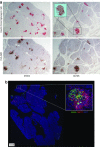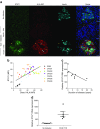Islet cell hyperexpression of HLA class I antigens: a defining feature in type 1 diabetes
- PMID: 27506584
- PMCID: PMC5042874
- DOI: 10.1007/s00125-016-4067-4
Islet cell hyperexpression of HLA class I antigens: a defining feature in type 1 diabetes
Abstract
Aims/hypothesis: Human pancreatic beta cells may be complicit in their own demise in type 1 diabetes, but how this occurs remains unclear. One potentially contributing factor is hyperexpression of HLA class I antigens. This was first described approximately 30 years ago, but has never been fully characterised and was recently challenged as artefactual. Therefore, we investigated HLA class I expression at the protein and RNA levels in pancreases from three cohorts of patients with type 1 diabetes. The principal aims were to consider whether HLA class I hyperexpression is artefactual and, if not, to determine the factors driving it.
Methods: Pancreas samples from type 1 diabetes patients with residual insulin-containing islets (n = 26) from the Network for Pancreatic Organ donors with Diabetes (nPOD), Diabetes Virus Detection study (DiViD) and UK recent-onset type 1 diabetes collections were immunostained for HLA class I isoforms, signal transducer and activator of transcription 1 (STAT1), NLR family CARD domain containing 5 (NLRC5) and islet hormones. RNA was extracted from islets isolated by laser-capture microdissection from nPOD and DiViD samples and analysed using gene-expression arrays.
Results: Hyperexpression of HLA class I was observed in the insulin-containing islets of type 1 diabetes patients from all three tissue collections, and was confirmed at both the RNA and protein levels. The expression of β2-microglobulin (a second component required for the generation of functional HLA class I complexes) was also elevated. Both 'classical' HLA class I isoforms (i.e. HLA-ABC) as well as a 'non-classical' HLA molecule, HLA-F, were hyperexpressed in insulin-containing islets. This hyperexpression did not correlate with detectable upregulation of the transcriptional regulator NLRC5. However, it was strongly associated with increased STAT1 expression in all three cohorts. Islet hyperexpression of HLA class I molecules occurred in the insulin-containing islets of patients with recent-onset type 1 diabetes and was also detectable in many patients with disease duration of up to 11 years, declining thereafter.
Conclusions/interpretation: Islet cell HLA class I hyperexpression is not an artefact, but is a hallmark in the immunopathogenesis of type 1 diabetes. The response is closely associated with elevated expression of STAT1 and, together, these occur uniquely in patients with type 1 diabetes, thereby contributing to their selective susceptibility to autoimmune-mediated destruction.
Keywords: DiViD; HLA class I; HLA-F; Islet cell; Pancreas; STAT1; Type 1 diabetes; nPOD.
Conflict of interest statement
Funding
We are pleased to acknowledge financial support from the European Union’s Seventh Framework Programme PEVNET (FP7/2007-2013, grant agreement number 261441). The participants of the PEVNET consortium are described at
Duality of interest
The authors declare that there is no duality of interest associated with this manuscript.
Contribution statement
SJR and NGM designed the study, performed data analysis and interpretation, and drafted, revised and approved the manuscript. TR-C, ICG, MZ, MAR and PL performed data collection, analysis and interpretation, and revised and approved the manuscript. LK and KD-J collected patient material, and revised and approved the manuscript. ICG and CEM designed the Affymetrix array component of the study, and revised and approved the manuscript. JSK provided statistical expertise, and revised and approved the manuscript. MvH, AP and MAA provided critical interpretation of the data, and revised and approved the manuscript.
SJR and NGM are the guarantors of this work and, as such, had full access to all the data in the study and take responsibility for the integrity of the data and the accuracy of the data analysis.
Figures






References
Publication types
MeSH terms
Substances
Grants and funding
LinkOut - more resources
Full Text Sources
Other Literature Sources
Medical
Research Materials
Miscellaneous

